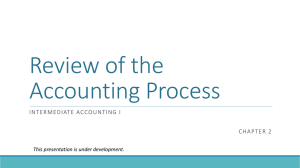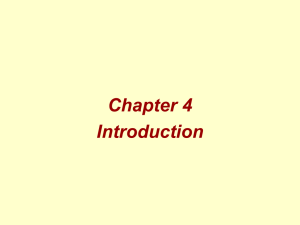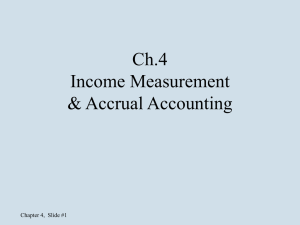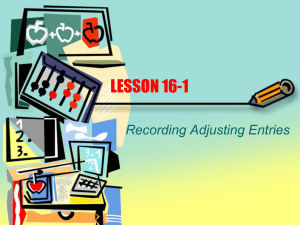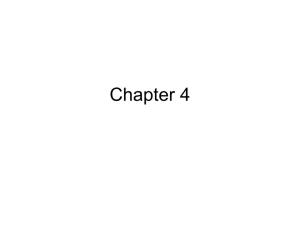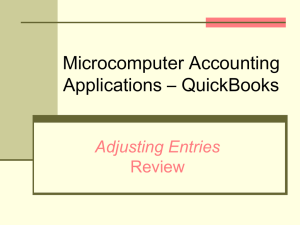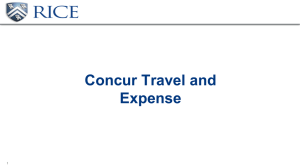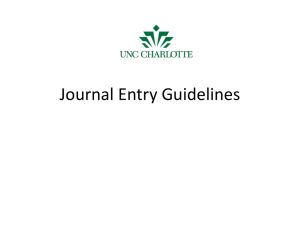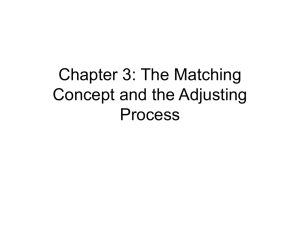Mastering Adjusting
advertisement
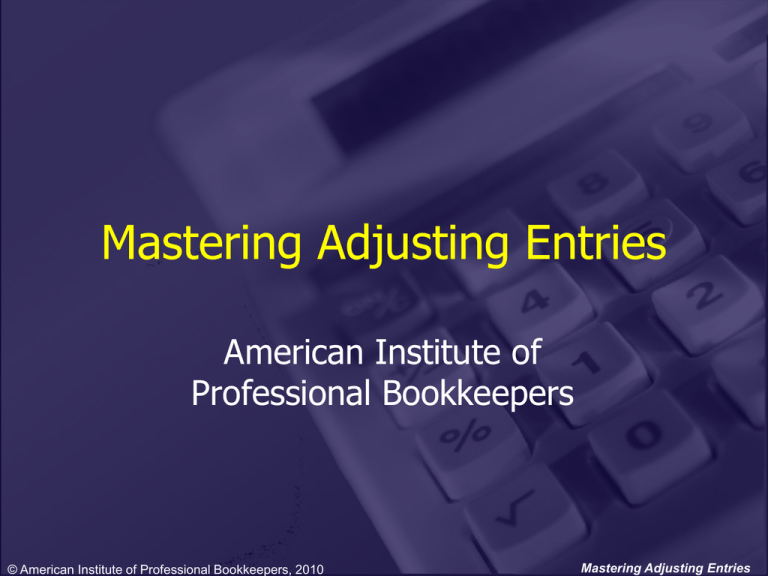
Mastering Adjusting Entries American Institute of Professional Bookkeepers © American Institute of Professional Bookkeepers, 2010 Mastering Adjusting Entries Cash v. Accrual Basis Cash basis Accrual basis Revenues recognized when cash is received Revenues recognized when earned Expenses recognized when cash is paid Expenses recognized when incurred Mastering Adjusting Entries Cash v. Accrual Basis In 2008, PubCo offers 2-year subscriptions to New Magazine, for $20 (8 quarterly issues @ $2.50) and collects $20,000. Cost: $6 a year per subscriber, which is paid at the time of publication. PubCo takes out a 2-year loan for $10,000 at 10% simple interest rate. Both interest and principal are payable at the end of 2 years. Mastering Adjusting Entries Cash v. Accrual Basis Revenue Publishing Expense Interest Expense Profit Cash basis 20X8 20X9 $20,000 $ -0 6,000 6,000 2,000 -0$14,000 ($8,000) Accrual basis 20X8 20X9 $10,000 $10,000 6,000 6,000 1,000 $3,000 1,000 $3,000 Total profit for 2 years is the same under both methods: $6,000 But, the timing of those profits may be different. Mastering Adjusting Entries Cash v. Accrual Basis Cash basis Accrual basis Revenues recognized when cash is received Revenues recognized when earned Expenses recognized when cash is paid Expenses recognized when incurred Earnings = cash received – expenses paid. Earnings = revenues earned – expenses incurred (When revenues are earned or expenses incurred is irrelevant.) (When cash is received or expenses paid is irrelevant.) Mastering Adjusting Entries Cash v. Accrual Basis Cash basis Accrual basis Revenues recognized when cash is received Revenues recognized when earned Expenses recognized when cash is paid Expenses recognized when incurred Earnings cash received NOT= GAAP – expenses paid. Earnings = revenues earned – expenses incurred (When revenues are earned or expenses incurred is irrelevant.) (When cash is received or expenses paid is irrelevant.) Mastering Adjusting Entries Cash v. Accrual Basis You are a caterer. The transactions you are about to see occur in March. What should you report as March revenues and expenses under: cash basis accounting? accrual basis accounting? Mastering Adjusting Entries Cash v. Accrual BasisCash Accrual Prepay $2,400 rent for 4 months (includes the current month). $2,400 $ 600 Receive $300 cash for catering services. $ 300 $ 300 Cater a luncheon and submit an invoice for $1,200 that will be settled next month. $ 0 $1,200 Receive a $200 utility bill that you will pay next month. $ 0 $ 200 Receive $1,000 from a customer for a function catered last month. $1,000 $ 0 Receive a $500 deposit on a wedding you will cater later in the year. $ 500 $ 0 Mastering Adjusting Entries Adjusting Entries Here are the principles of adjusting entries: Recognition of revenues and expenses is unrelated to receipt or payment of cash. Cash may be received before or after the service is performed (or goods are sold). Cash may be paid before or after the expense is incurred. Adjusting entries are used when cash is received or paid at a different time from when the service is performed (or goods are sold) or the expense is incurred. Mastering Adjusting Entries Adjusting Entries In 2008, PubCo offers 2-year subscriptions to New Magazine, for $20 (8 quarterly issues @ $2.50) and collects $20,000. Cash 20,000 o r Cash 20,000 Unearned Revenue 20,000 Revenue 20,000 But neither entry records the amount of revenue earned in 20X8 on the accrual basis: $10,000. How can this be corrected? Mastering Adjusting Entries Adjusting Entries Adjusting entries apply the accrual method to transactions when cash flows and earnings (revenues less expenses) are not simultaneous. Cash flows AFTER the revenue is earned or expense is incurred Cash flows BEFORE the revenue is earned or expense is incurred Mastering Adjusting Entries Adjusting Entries Cash flows AFTER the revenue is earned or expense is incurred Revenues earned, but cash not yet received Expenses incurred, but not yet paid Cash flows BEFORE the revenue is earned or expense is incurred Cash received, but not yet earned Expenses paid, but not yet incurred Mastering Adjusting Entries Adjusting Entries Cash flows AFTER the revenue is earned or expense is incurred Revenues earned, but cash not yet received Expenses incurred, but not yet paid Cash flows BEFORE the revenue is earned or expense is incurred Cash received, but not yet earned Expenses paid, but not yet incurred Mastering Adjusting Entries Adjusting Entries Cash flows AFTER the revenue is earned or expense is incurred Revenues earned, but cash not yet received ComCo lends ZyCo $10,000 on July 1 and will be repaid the $10,000 principal + $1,200 interest on June 30 of the following year. Mastering Adjusting Entries Adjusting Entries Cash flows AFTER the revenue is earned or expense is incurred Revenues earned, but cash not yet received ComCo lends ZyCo $10,000 on July 1 and will be repaid the $10,000 principal + $1,200 interest on June 30 of the following year. ComCo earns revenue each month the loan is not repaid. As of Dec. 31, it has earned 6 months’ interest. To compute: $1,200/12 months = $100 a month 6 months = $600 earned revenue Mastering Adjusting Entries Adjusting Entries Cash flows AFTER the revenue is earned or expense is incurred Revenues earned, but cash not yet received ComCo lends ZyCo $10,000 on July 1 and will be repaid the $10,000 principal + $1,200 interest on June 30 of the following year. ComCo records an adjusting entry to show that it earned $600 revenue: Interest Receivable Interest Revenue 600 600 Mastering Adjusting Entries Adjusting Entries Cash flows AFTER the revenue is earned or expense is incurred Thus, the adjusting entry to accrue revenue is: Revenues earned, but cash not yet received ____ Receivable ____ Revenue In addition to interest, other common accrued revenues include commissions, royalties and rent. Mastering Adjusting Entries Adjusting Entries Cash flows AFTER the revenue is earned or expense is incurred Thus, the adjusting entry to accrue revenue is: Revenues earned, but cash not yet received ____ Receivable ____ Revenue This adjusting entry increases assets . . . and increases revenues/net income. Mastering Adjusting Entries Adjusting Entries Cash flows AFTER the revenue is earned or expense is incurred Thus, the adjusting entry to accrue revenue is: Revenues earned, but cash not yet received ____ Receivable ____ Revenue Mastering Adjusting Entries Adjusting Entries Cash flows AFTER the revenue is earned or expense is incurred Thus, the adjusting entry to accrue revenue is: Revenues earned, but cash not yet received ____ Receivable ____ Revenue Because this entry increases assets, if it is omitted, assets will be UNDERSTATED. Because the entry increases income, if it is omitted, net income will be UNDERSTATED. Mastering Adjusting Entries Adjusting Entries Cash flows AFTER the revenue is earned or expense is incurred Revenues earned, but cash not yet received Expenses incurred, but not yet paid Cash flows BEFORE the revenue is earned or expense is incurred Cash received but not yet earned Expenses paid but not yet incurred Mastering Adjusting Entries Adjusting Entries Cash flows AFTER the revenue is earned or expense is incurred Expenses incurred, but not yet paid KTC pays its office staff $5,000 every 2 weeks. The final payday for the year ended Oct. 31, 20X1, is Friday, Oct. 24. What adjustment is needed on Oct. 31 (the company’s year end)? Mastering Adjusting Entries Adjusting Entries Cash flows AFTER the revenue is earned or expense is incurred Expenses incurred, but not yet paid KTC pays its office staff $5,000 every 2 weeks. The final payday for the year ended Oct. 31, 20X1, is Friday, Oct. 24. What adjustment is needed on Oct. 31 (the company’s year end)? 24 26 27 28 29 30 25 31 Mastering Adjusting Entries Adjusting Entries Cash flows AFTER the revenue is earned or expense is incurred Expenses incurred, but not yet paid KTC pays its office staff $5,000 every 2 weeks. The final payday for the year ended Oct. 31, 20X1, is Friday, Oct. 24. What adjustment is needed on Oct. 31 (the company’s year end)? 24 26 27 28 29 30 25 31 For these days, labor costs were incurred . . . Mastering Adjusting Entries Adjusting Entries Cash flows AFTER the revenue is earned or expense is incurred Expenses incurred, but not yet paid KTC pays its office staff $5,000 every 2 weeks. The final payday for the year ended Oct. 31, 20X1, is Friday, Oct. 24. What adjustment is needed on Oct. 31 (the company’s year end)? 24 26 27 28 29 30 25 31 but not paid by year end Mastering Adjusting Entries Adjusting Entries Cash flows AFTER the revenue is earned or expense is incurred Expenses incurred, but not yet paid KTC pays its office staff $5,000 every 2 weeks. The final payday for the year ended Oct. 31, 20X1, is Friday, Oct. 24. What adjustment is needed on Oct. 31 (the company’s year end)? KTC must record an adjusting entry to recognize 1 week’s wage expense. Wages Expense Wages Payable 2,500 2,500 Mastering Adjusting Entries Adjusting Entries Cash flows AFTER the revenue is earned or expense is incurred Thus, the adjusting entry to accrue expenses is Expenses incurred, but not yet paid ____ Expense ____ Payable In addition to wages, other common accrued expenses include rent, commissions, royalties, utilities, and interest. Mastering Adjusting Entries Adjusting Entries Cash flows AFTER the revenue is earned or expense is incurred Thus, the adjusting entry to accrue expenses is Expenses incurred, but not yet paid ____ Expense ____ Payable This adjusting entry increases expenses (and therefore reduces net income) . . . and increases liabilities. Mastering Adjusting Entries Adjusting Entries Cash flows AFTER the revenue is earned or expense is incurred Thus, the adjusting entry to accrue expenses is Expenses incurred, but not yet paid ____ Expense ____ Payable Mastering Adjusting Entries Adjusting Entries Cash flows AFTER the revenue is earned or expense is incurred Thus, the adjusting entry to accrue expenses is Expenses incurred, but not yet paid ____ Expense ____ Payable Because this entry reduces net income, if it is omitted, net income will be OVERSTATED. Because this entry increases liabilities, if it is omitted, liabilities will be UNDERSTATED. Mastering Adjusting Entries Adjusting Entries Cash flows AFTER the revenue is earned or expense is incurred Revenues earned, but cash not yet received Expenses incurred, but not yet paid Cash flows BEFORE the revenue is earned or expense is incurred Cash received, but not yet earned Expenses paid, but not yet incurred Mastering Adjusting Entries Adjusting Entries Cash flows BEFORE the revenue is earned or expense is incurred On March 1, StorageCo rents out a unit and receives $900 for the first 3 months’ rent. The Cash received, company has a year end of April 30. but not yet earned Mastering Adjusting Entries Adjusting Entries Cash flows BEFORE the revenue is earned or expense is incurred On March 1, StorageCo rents out a unit and receives $900 for the first 3 months’ rent. The Cash received, company has a year end of April 30. The $900 payment received in advance can but not yet be recorded in two ways: earned Cash Cash 900 900 Unearned Rent 900 Rent Revenue 900 Mastering Adjusting Entries Adjusting Entries Cash flows BEFORE the revenue is earned or expense is incurred On March 1, StorageCo rents out a unit and receives $900 for the first 3 months’ rent. The Cash received, company has a year end of April 30. The $900 payment received in advance can but not yet be recorded in two ways: earned Cash Cash 900 900 Unearned Rent 900 Rent Revenue 900 3/1 4/30 5/31 Mastering Adjusting Entries Adjusting Entries Cash flows BEFORE the revenue is earned or expense is incurred On March 1, StorageCo rents out a unit and receives $900 for the first 3 months’ rent. Cash received, but not yet Rent Revenue earned 600 600 Unearned Rent 3/1 600 900 300 Mastering Adjusting Entries Adjusting Entries Cash flows BEFORE the revenue is earned or expense is incurred On March 1, StorageCo rents out a unit and receives $900 for the first 3 months’ rent. Cash received, but not yet Rent Revenue earned 600 Unearned Rent 3/1 Unearned Rent 600 Revenue Rent 600 600 900 600300 Mastering Adjusting Entries Adjusting Entries Cash flows BEFORE the revenue is earned or expense is incurred On March 1, StorageCo rents out a unit and receives $900 for the first 3 months’ rent. Cash received, but not yet Rent Revenue earned 3/1 900 300 600 Unearned Rent 300 300 Mastering Adjusting Entries Adjusting Entries Cash flows BEFORE the revenue is earned or expense is incurred On March 1, StorageCo rents out a unit and receives $900 for the first 3 months’ rent. Cash received, but not yet Rent Revenue earned 3/1 900 300 Rent Revenue 600 Unearned Rent Unearned Rent 300 300 300300 Mastering Adjusting Entries Adjusting Entries Cash flows BEFORE the revenue is earned or expense is incurred How the AJE is made depends on how receipt of the $900 payment was recorded. It could be: Unearned ___ Rev. ___ Revenue Cash received, ___ Revenue Unearned ___ Rev. but not yet earned This is the AJE if the This is the AJE if the cash was recorded as cash was recorded as revenue unearned revenue Mastering Adjusting Entries Adjusting Entries Cash flows BEFORE the revenue is earned or expense is incurred How the AJE is made depends on how receipt of the $900 payment was recorded. It could be: Unearned ___ Rev. ___ Revenue Cash received, ___ Revenue Unearned ___ Rev. but not yet earned This AJE reduces This AJE reduces liabilities . . . net income . . . . . . and increases net income . . . and increases liabilities Mastering Adjusting Entries Adjusting Entries Cash flows BEFORE the revenue is earned or expense is incurred How the AJE is made depends on how receipt of the $900 payment was recorded. It could be: Unearned ___ Rev. ___ Revenue Cash received, ___ Revenue Unearned ___ Rev. but not yet earned Mastering Adjusting Entries Adjusting Entries Cash flows BEFORE the revenue is earned or expense is incurred How the AJE is made depends on how receipt of the $900 payment was recorded. It could be: Unearned ___ Rev. Cash received, ___ Revenue but not yet earned This AJE reduces This entry increases liabilities—without it, net income—without it, liabilities will be net income will be OVERSTATED UNDERSTATED Mastering Adjusting Entries Adjusting Entries Cash flows BEFORE the revenue is earned or expense is incurred How the AJE is made depends on how receipt of the $900 payment was recorded. It could be: ___ Revenue Cash received, Unearned ___ Rev. but not yet earned This AJE increases This entry reduces net liabilities; without it, income—without it, net liabilities will be income will be UNDERSTATED OVERSTATED Mastering Adjusting Entries Adjusting Entries Cash flows AFTER the revenue is earned or expense is incurred Revenues earned, but cash not received Expenses incurred, but not paid Cash flows BEFORE the revenue is earned or expense is incurred Cash received, but not yet earned Expenses paid, but not yet incurred Mastering Adjusting Entries Adjusting Entries Cash flows BEFORE the revenue is earned or expense is incurred On Sept. 1, NewCo, a calendar year company, purchases a 1-year insurance policy for $600. Expenses paid, but not yet incurred Mastering Adjusting Entries Adjusting Entries Cash flows BEFORE the revenue is earned or expense is incurred On Sept. 1, NewCo, a calendar year company, purchases a 1-year insurance policy for $600. The $600 paid on Sept. 1 can be recorded Expenses paid, but not in two ways: yet incurred Prepaid Ins. 600 Insurance Exp. 600 Cash 600 Cash 600 Mastering Adjusting Entries Adjusting Entries Cash flows BEFORE the revenue is earned or expense is incurred On Sept. 1, NewCo, a calendar year company, purchases a 1-year insurance policy for $600. The $600 paid on Sept. 1 can be recorded Expenses paid, but not in two ways: yet incurred Prepaid Ins. 600 Insurance Exp. 600 Cash 600 Cash 600 9/1 12/31 8/31 Mastering Adjusting Entries Adjusting Entries Cash flows BEFORE the revenue is earned or expense is incurred On Sept. 1, NewCo, a calendar year company, purchases a 1-year insurance policy for $600. Expenses paid, but not yet incurred Insurance Expense 200 200 9/1 Prepaid Insurance 600 200 400 Mastering Adjusting Entries Adjusting Entries Cash flows BEFORE the revenue is earned or expense is incurred On Sept. 1, NewCo, a calendar year company, purchases a 1-year insurance policy for $600. Expenses paid, but not yet incurred Insurance Expense 200 9/1 Prepaid Insurance 600 200 Insurance Expense 200 200Prepaid Insurance 400 200 Mastering Adjusting Entries Adjusting Entries Cash flows BEFORE the revenue is earned or expense is incurred On Sept. 1, NewCo, a calendar year company, purchases a 1-year insurance policy for $600. Expenses paid, but not yet incurred 9/1 Insurance Expense 600 400 Prepaid Insurance 400 200 400 Mastering Adjusting Entries Adjusting Entries Cash flows BEFORE the revenue is earned or expense is incurred On Sept. 1, NewCo, a calendar year company, purchases a 1-year insurance policy for $600. Expenses paid, but not yet incurred 9/1 Insurance Expense 600 400 Prepaid Insurance 400 Prepaid Insurance 400 200Insurance Expense 400 400 Mastering Adjusting Entries Adjusting Entries Cash flows BEFORE the revenue is earned or expense is incurred Expenses paid, but not yet incurred How the AJE is made depends on how the $600 payment was recorded. It could be: ____ Expense Prepaid Exp. Prepaid Exp. ____Expense This is the AJE if the payment was recorded in a asset account This is the AJE if the payment was recorded in an expense account Mastering Adjusting Entries Adjusting Entries Cash flows BEFORE the revenue is earned or expense is incurred How the AJE is made depends on how the $600 payment was recorded. It could be: ____ Expense Prepaid Exp. Prepaid Exp. ____Expense Expenses paid, but not yet incurred This AJE reduces net income . . . This AJE increases assets . . . . . . and reduces assets . . . and increases net income Mastering Adjusting Entries Adjusting Entries Cash flows BEFORE the revenue is earned or expense is incurred Expenses paid, but not yet incurred How the AJE is made depends on how the $600 payment was recorded. It could be: ____ Expense Prepaid Exp. Prepaid Exp. ____Expense Mastering Adjusting Entries Adjusting Entries Cash flows BEFORE the revenue is earned or expense is incurred How the AJE is made depends on how the $600 payment was recorded. It could be: ____ Expense Prepaid Exp. Expenses paid, but not It also reduces yet incurred This AJE increases expenses—without it, net assets—without it, income will be assets will be OVERSTATED OVERSTATED Mastering Adjusting Entries Adjusting Entries Cash flows BEFORE the revenue is earned or expense is incurred How the AJE is made depends on how the $600 payment was recorded. It could be: Prepaid Exp. ____Expense Expenses paid, but not yet incurred This entry increases assets—without it, assets will be UNDERSTATED It also reduces expenses —without it, net income will be UNDERSTATED Mastering Adjusting Entries Basic Adjustments--Summary Type of Adj. AJE Financial Statement Effect if AJE not Made Accrued Expense Liability Expense Expenses are understated and net income is overstated. Liabilities are understated. Accrued Asset Revenue Revenue Assets are understated. Revenues and net income are understated. Prepaid Expense Expense Asset Asset Expense Expenses are understated and net income is overstated. Assets are overstated. Deferred Liability Revenue Revenue Revenue Liability Liabilities are overstated. Revenues and net income are understated. Assets are understated. Expenses are overstated and net income is understated. Revenues and net income are overstated. Liabilities are understated. Mastering Adjusting Entries Adjusting Entries In addition to the AJEs needed for routine accruals and deferrals, there are other endof-period adjusting entries, including: depreciation expense bad debt expense Mastering Adjusting Entries Depreciation Expense The AJE to recognize depreciation for the period is: Depreciation Expense xxx Accumulated Depreciation xxx This entry increases expenses. It also reduces assets because the year-end balance in Accumulated Depreciation is subtracted from the related asset account to arrive at that asset’s net book value. Mastering Adjusting Entries Depreciation Expense Straight-line depreciation expense is calculated as follows: Cost - Residual value Estimated useful life (in years) = Annual depreciation expense Mastering Adjusting Entries Depreciation Expense PatCo purchases for its business equipment that costs 25,000 PatCo estimates that the equipment will have $25,000. a useful life of 6 years and, at the end of its life will 1,000 have a residual value of $1,000. Residual Cost value Annual depreciation = expense Estimated $4,000 useful life Each year, Patco will make the following adjusting entry: Depreciation Expense 4,000 Accumulated Depreciation 4,000 Mastering Adjusting Entries Depreciation Expense Each year, the balance in Accumulated Depreciation increases as follows: Accumulated Equipment Depreciation 25,000 4,000 Yr 1 4,000 Yr 2 4,000 Yr 3 12,000 At the end of Year 3, PatCo will report on its balance sheet: Equipment - At Cost Less: Accumulated Depreciation Equipment (net) 25,000 12,000 13,000 Mastering Adjusting Entries Bad Debt Expense The matching principle requires an attempt to match costs with the revenues that the costs helped produce. One application of the matching principle is bad debt. The matching principle requires companies to estimate bad debt (a cost), then match the bad debt to its related noncash sales (revenue). Mastering Adjusting Entries Bad Debt Expense The entry to record bad debt expense is: Bad Debt Expense Allowance For Doubtful Accounts xxx xxx This entry reduces income and reduces assets (the credit to Allowance For Doubtful Accounts is subtracted from Accounts Receivable). The difference between the ending balances in Accounts Receivable and Allowance For Doubtful Accounts is the net realizable value. Accounts Receivable Less: Allowance For Doubtful Accts Net Realizable Value 35,000 4,200 30,800 Mastering Adjusting Entries Estimating Bad Debt Expense Bad debt for book purposes can be estimated in either of two ways: 1. as a percentage of credit sales; or 2. as the percentage of accounts receivable that the company estimates it will not be able to collect. Mastering Adjusting Entries Estimating Bad Debt Expense 1. As a percentage of credit sales. A firm estimates the percentage of credit sales it will not collect and each year takes that amount as bad debt expense. Driscoll Co. estimates that each year 2% of its credit sales will be uncollectible. Credit 200,000 sales for 20X8 are $200,000. = 4,000 The adjusting entry to record bad debt expense for 20X8 is: Bad Debt Expense Allowance For Doubtful Accounts 4,000 4,000 Mastering Adjusting Entries Estimating Bad Debt Expense 1. As a percentage of credit sales. A firm estimates the percentage of credit sales it will not collect and each year takes that amount as bad debt expense. Note that when using the percentage of credit sales method, the balance in Allowance For Doubtful Accounts is irrelevant to the AJE. Mastering Adjusting Entries Estimating Bad Debt Expense 2. As a percentage of A/R estimated to be uncollectible. At year-end, the balance in Allowance account is adjusted to reflect the percentage of accounts receivable estimated to be uncollectible. Potage’s A/R has a year-end balance of $20,000. 20,000 It estimates that 3% of this amount will be uncollectible. The Allowance For Doubtful Accounts currently has a $400 400 credit balance. = 600 So, the Allowance account must be adjusted to end 600 credit balance. with a $600 Allowance For Doubtful Accounts current balance Mastering Adjusting Entries Estimating Bad Debt Expense 2. As a percentage of A/R estimated to be uncollectible. At year-end, the balance in Allowance account is adjusted to reflect the percentage of accounts receivable estimated to be uncollectible. Potage’s A/R has a year-end balance of $20,000. It estimates that 3% of this amount will be uncollectible. The Allowance For Doubtful Accounts currently has a $400 credit balance. Bad Debt Exp. 200 Allowance 200 Allowance For Doubtful Accounts 400 200 adjustment 600 Mastering Adjusting Entries Estimating Bad Debt Expense 2. As a percentage of A/R estimated to be uncollectible. At year-end, the balance in Allowance account is adjusted to reflect the percentage of accounts receivable estimated to be uncollectible. Allowance For Doubtful Accounts x,xxx x,xxx x,xxx (based on calculation) Mastering Adjusting Entries Estimating Bad Debt Expense StoreCo’s Accounts Receivable currently has a balance of $50,000. Its Allowance account has a $3,000 debit balance. StoreCo estimates that 5% of accounts receivable will be uncollectible. Bad Debt Expense 5,500 5,500 Allowance For Doubtful Accounts 3,000 5,500 2,500 ($50,000 5%) 5,500 Bad Debt Expense 5,500 Allowance For Doubtful Accounts Mastering Adjusting Entries Estimating Bad Debt Expense StoreCo’s Accounts Receivable currently has a balance of $50,000. Its Allowance account has a $3,000 debit balance. StoreCo estimates that 5% of accounts receivable will be uncollectible. Allowance For Doubtful Accounts 3,000 2,500 Mastering Adjusting Entries Estimating Bad Debt Expense Once a customer’s account is deemed uncollectible, it is taken off the books: Allowance For Doubtful Accounts Accounts Receivable xxx xxx This entry has no effect on total assets because it reduces Accounts Receivable and its offsetting Allowance account by the same amount. Mastering Adjusting Entries Tips on Adjusting Journal Entries Every AJE must include at least: one income statement account (revenue or expense) and one balance sheet account (asset or liability) Never cash! Mastering Adjusting Entries The Chart of Accounts Companies generally number GL accounts. Each category of accounts is given a series of numbers. For example: Assets Liabilities Owners Equity Revenue Expense 100 200 300 400 500 – 199 – 299 – 399 – 499 - 599 Mastering Adjusting Entries Normal Balances All accounts have a normal balance e.g., for A/R a debit balance is normal. The normal balance is the side (debit or credit) on which an increase is recorded. For example, to increase Cash, you debit it, so Cash normally has a debit balance. To increase Revenue, you credit it, so Revenue normally has a credit balance. Mastering Adjusting Entries Normal Balances Assets Owners’ Equity Liabilities increases increases increases normal balance normal balance normal balance Revenues Expenses increases increases normal balance normal balance Mastering Adjusting Entries Normal Balances: Exercise Account Normal bal. type Debit Credit Account Cash Asset DR Asset DR Accounts Receivable Asset DR Inventory Prepaid Rent Asset DR Asset CR Accumulated Depreciation Liability CR Accounts Payable Unearned Revenue Liability CR Equipment Asset DR Cost of Goods Sold Expense DR Expense DR Rent Expense Sales Revenue Revenue CR Owner, Capital O/E CR Allowance For Doubtful Accounts Asset CR Asset DR Land Building Adjusting Entries AssetMastering DR The Worksheet Trial balance Accounts Dr Cr The first step in the trial balance is the unadjusted trial balance. Under Accounts, list each account title. Under Trial balance, enter that account’s balance in the appropriate column. Mastering Adjusting Entries The Worksheet Trial balance Accounts Dr Cr Adjustments Dr Cr Under Adjustments enter any end-ofperiod adjustment to the account—an accrual, deferral or other adjustment. Mastering Adjusting Entries Trial balance Accounts Dr Cr Adjustments Dr Cr Adjusted TB Dr Cr Under Adjusted trial Balance, enter the adjusted account balance (i.e., including any accrual, deferral or other adjustment). Mastering Adjusting Entries Funkytime Worksheet For the year ended July 31, 2009 Trial balance Account Title Cash Accounts Receivable Supplies Prepaid Insurance Land Office Equipment Accounts Payable Unearned Rent Bert Weems, Capital Bert Weems, Drawing Fees Earned Wages Expense Rent Expense Supplies Expense Utilities Expense Insurance Expense Debit 3,000 2,200 2,000 2,400 18,000 1,800 3,000 4,275 2,600 800 985 440 Credit Adjustments Debit minus 1,900 300 24,000 Credit 1,600 Adjusted trial balance Debit Credit 400 The first step it is the unadjusted trial balance 15,300 plus 41,500 41,500 1,600 2,400 Example: Supplies Expense must be adjusted to show that only $400 worth of supplies are on hand at Mastering year Adjusting end. Entries Funkytime Worksheet For the year ended July 31, 2009 Trial balance Account Title Cash Accounts Receivable Supplies Prepaid Insurance Land Office Equipment Accounts Payable Unearned Rent Bret Weems, Capital Bret Weems, Drawing Fees Earned Wages Expense Rent Expense Supplies Expense Utilities Expense Insurance Expense Debit 3,000 2,200 2,000 2,400 18,000 1,800 3,000 4,275 2,600 800 985 440 Adjustments Credit Debit minus Credit 1,600 400 Adjusted trial balance Debit Credit 400 2,000 1,900 300 24,000 15,300 plus 1,600 2,400 400 840 Example: The 12- month insurance was purchased onMastering JuneAdjusting 1. Entries 41,500policy 41,500 Funkytime Worksheet For the year ended July 31, 2009 Trial balance Account Title Cash Accounts Receivable Supplies Prepaid Insurance Land Office Equipment Accounts Payable Unearned Rent Bret Weems, Capital Bret Weems, Drawing Fees Earned Wages Expense Rent Expense Supplies Expense Utilities Expense Insurance Expense Debit 3,000 2,200 2,000 2,400 18,000 1,800 3,000 4,275 2,600 800 985 440 Credit Adjustments Debit Credit 1,600 400 Adjusted trial balance Debit Credit 400 2,000 1,900 300 24,000 15,300 1,600 2,400 400 840 When all the adjustments are entered in the Adjustments columns, the new balances are entered in the Adjusted trial balance columns Mastering Adjusting Entries Funkytime Worksheet For the year ended July 31, 2009 Trial balance Account Title Cash Accounts Receivable Supplies Prepaid Insurance Land Office Equipment Accounts Payable Unearned Rent Bret Weems, Capital Bret Weems, Drawing Fees Earned Wages Expense Rent Expense Supplies Expense Utilities Expense Insurance Expense Wages Payable Rent Revenue Depreciation Exp. Accumulated Depr. Debit 3,000 2,200 2,000 2,400 18,000 1,800 3,000 4,275 2,600 800 985 440 Credit 1,900 300 24,000 15,300 Adjustments Debit Credit Debit 3,000 2,200 1,600 400 400 2,000 18,000 1,800 120 3,000 375 1,600 400 100 41,500 41,500 Adjusted trial balance 2,595 375 120 4,650 2,600 2,400 985 840 100 Credit 1,900 180 24,000 15,300 375 120 100 100 2,595 Mastering 41,975 41,975 Adjusting Entries Funkytime Worksheet For the year ended July 31, 2009 Mastering Adjusting Entries Funkytime Worksheet For the year ended July 31, 2009 Adjusted trial balance Account Title Cash Accounts Receivable Supplies Prepaid Insurance Land Office Equipment Accounts Payable Unearned Rent Bret Weems, Capital Bret Weems, Drawing Fees Earned Wages Expense Rent Expense Supplies Expense Utilities Expense Insurance Expense Wages Payable Rent Revenue Depreciation Exp. Accumulated Depr. Debit 3,000 2,200 400 2,000 18,000 1,800 3,000 4,650 2,600 2,400 985 840 100 41,975 Credit 1,900 180 24,000 15,300 Income statement Debit Credit Balance sheet Debit Credit The revenue and expense balances are extended from the Adjusted trial balance columns to the Income statement columns, and . . . 375 120 100 41,975 Mastering Adjusting Entries Funkytime Worksheet For the year ended July 31, 2009 Adjusted trial balance Account Title Cash Accounts Receivable Supplies Prepaid Insurance Land Office Equipment Accounts Payable Unearned Rent Bret Weems, Capital Bret Weems, Drawing Fees Earned Wages Expense Rent Expense Supplies Expense Utilities Expense Insurance Expense Wages Payable Rent Revenue Depreciation Exp. Accumulated Depr. Debit 3,000 2,200 400 2,000 18,000 1,800 3,000 4,650 2,600 2,400 985 840 100 41,975 Credit 1,900 180 24,000 15,300 Income statement Debit Credit Balance sheet Debit Credit The asset, liability and owner’s equity balances are extended from the Adjusted trial balance to the Balance sheet columns. 375 120 100 41,975 Mastering Adjusting Entries Funkytime Worksheet For the year ended July 31, 2009 Adjusted trial balance Account Title Cash Accounts Receivable Supplies Prepaid Insurance Land Office Equipment Accounts Payable Unearned Rent Bret Weems, Capital Bret Weems, Drawing Fees Earned Wages Expense Rent Expense Supplies Expense Utilities Expense Insurance Expense Wages Payable Rent Revenue Depreciation Exp. Accumulated Depr. Debit 3,000 2,200 400 2,000 18,000 1,800 3,000 4,650 2,600 2,400 985 840 100 41,975 Credit Income statement Debit Balance sheet Credit 3,000 2,200 400 2,000 18,000 1,800 1,900 180 24,000 15,300 375 120 100 41,975 Debit 4,650 2,600 2,400 985 840 100 11,575 15,300 120 3,000 Credit 1,900 180 24,000 375 100 15,420 Mastering 30,400 26,555 Adjusting Entries Funkytime Worksheet For the year ended July 31, 2009 Adjusted trial balance Account Title Fees Earned Wages Expense Rent Expense Supplies Expense Utilities Expense Insurance Expense Wages Payable Rent Revenue Depreciation Exp. Accumulated Depr. Debit 4,650 2,600 2,400 985 840 100 41,975 Credit 15,300 375 120 100 41,975 Income statement Debit 4,650 2,600 2,400 985 840 100 11,575 3,845 15,420 Balance sheet Credit Debit Credit 15,300 375 120 15,420 30,400 15,420 30,400 100 26,555 3,845 30,400 As a check, net income is added The to difference between the Income statement Debit and the Income statement Debit column and Balance sheet Credit column.Credit columns is net income. Mastering Adjusting Entries
